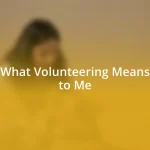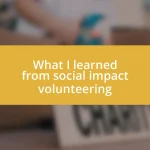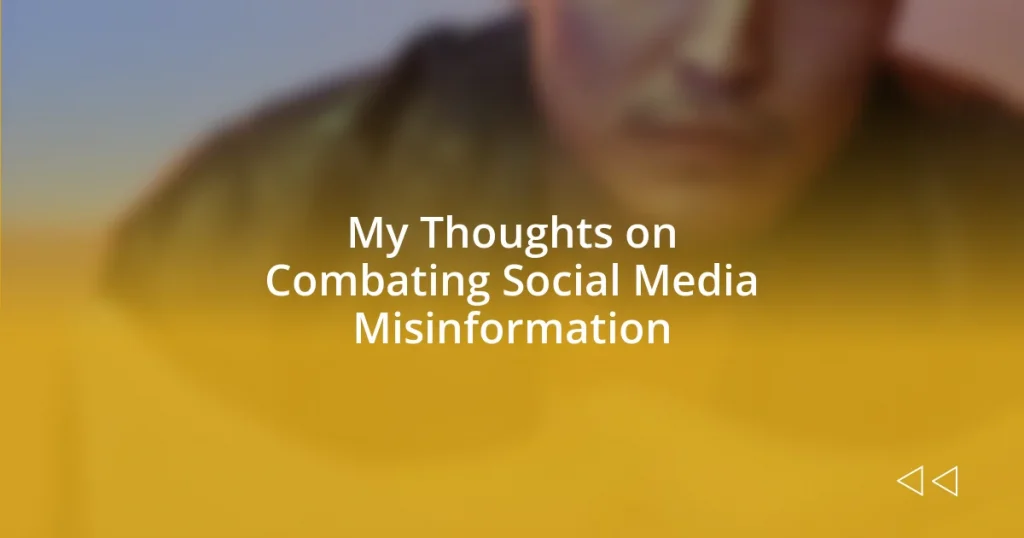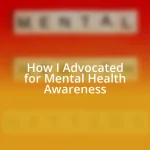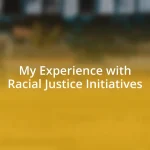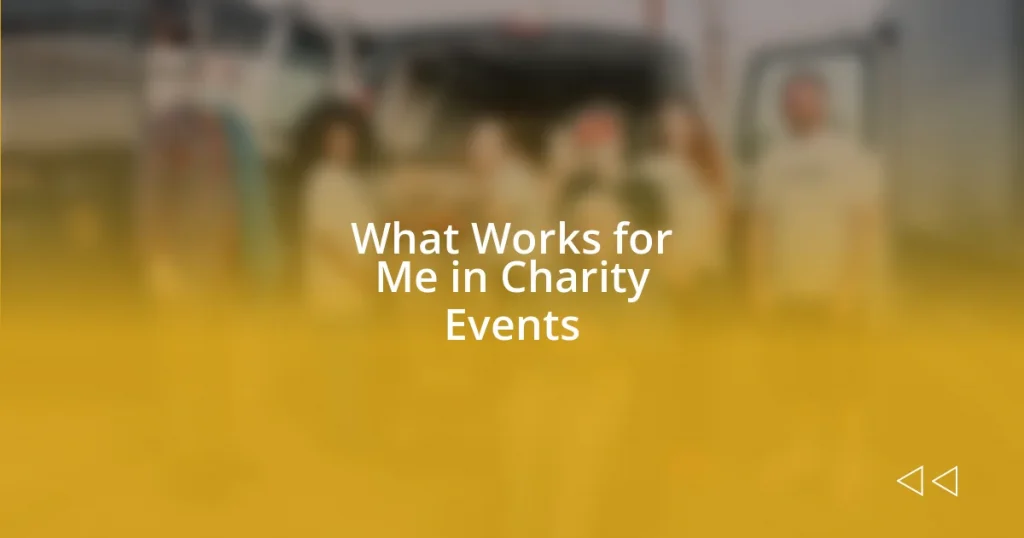Key takeaways:
- Misinformation thrives on emotions and sensationalism, leading to conflicts and misunderstandings within society.
- Critical thinking and fact-checking are essential skills for navigating social media, including questioning sources and consulting reliable data.
- Community engagement and responsible sharing practices play a crucial role in combating misinformation and promoting digital literacy.

Understanding Social Media Misinformation
Social media misinformation can spread like wildfire, often faster than the truth itself. I remember a time when a viral post claimed that a certain health supplement could cure a serious illness. Many friends shared it without a second thought. It made me wonder: why do we sometimes trust what we see online more than established facts?
Misinformation thrives on emotions, exploiting our fears and desires. It’s often the sensational headlines that catch our eye, drawing us in with promises or startling claims. I’ve found myself clicking on articles that I later regretted, realizing that they were not what they appeared to be. It’s a powerful reminder of how easily our beliefs can be swayed by misleading information.
Moreover, understanding the mechanisms behind this phenomenon is crucial. Algorithms are designed to prioritize engagement, often promoting sensational content over factual reporting. Have you ever felt a sense of urgency when reading a headline? It’s that compelling nature of misinformation that keeps us hooked. I believe that by recognizing these patterns, we can become more discerning consumers of information in our digital lives.

Impact of Misinformation on Society
Misinformation can deeply fracture our societal trust, blurring the lines between reality and fabrication. I remember when a sensational post about a celebrity scandal spread, and friends started arguing about it as if it were fact. It struck me how easily discussions can pivot from informed debates to heated conflict over something that might have been entirely false.
The consequences of misinformation extend beyond mere inconvenience; they can shape public opinion and influence critical decisions. For example, I once witnessed a community divided over a false claim about a local development project, leading to protests and even threats. It was alarming to see how quickly misinformation can mobilize people, showing that a single viral post can have tangible effects on community dynamics.
Moreover, the psychological toll of misinformation should not be underestimated. I’ve felt a sense of anxiety when I stumbled upon conflicting reports about global events, which only left me feeling confused and disheartened. This emotional chaos demonstrates how misinformation doesn’t just mislead us; it can foster a culture of distrust and fear within society.
| Impact of Misinformation | Examples |
|---|---|
| Trust Erosion | Arguments and conflicts over false claims |
| Public Misinformed Decisions | Protests based on viral misinformation |
| Emotional Distress | Confusion and anxiety from conflicting information |

Identifying Common Types of Misinformation
Identifying misinformation requires a keen eye for detail. Throughout my experience navigating social media, I’ve encountered various types that I now recognize. Some forms of misinformation are particularly prevalent and can easily mislead even the most discerning individuals.
Here are some common types of misinformation I’ve noticed:
- Fake News: Totally fabricated articles that mimic real news in structure but have no grounding in truth.
- Misleading Headlines: Clickbait that exaggerates or misrepresents the content of the article.
- Outdated Information: Sharing old news or studies as if they are current and relevant, which can distort public understanding.
- Manipulated Images or Videos: Content altered to provide a false narrative, often going viral due to its shocking nature.
- Conspiracy Theories: Claims that rely heavily on speculation, often lacking credible sources but appealing to emotions and fears.
Another observation I’ve made is the role of confirmation bias in amplifying misinformation. I recall a time when I stumbled upon an article that echoed my beliefs about a political issue. It felt reassuring, yet looking back, I realize how easily we can fall into that trap. It’s as if we’re drawn to information that confirms our opinions, shutting ourselves off from opposing viewpoints. This experience has taught me the importance of cross-checking sources and approaching information with a critical mindset.

Strategies for Fact-Checking Information
When it comes to effective fact-checking, I’ve found that the first step is diversifying your sources. I once came across a viral post that claimed a new health trend was miraculous. Instead of accepting it at face value, I took a few minutes to look up information from various reputable health organizations like the CDC or WHO. My effort paid off when I discovered that the trend was based on anecdotal evidence, not scientific research. This experience reinforced the value of consulting multiple sources to ensure you’re getting a well-rounded perspective.
Another strategy I highly recommend is using fact-checking websites, which can save you so much time and stress. I remember a particularly heated discussion among friends about an environmental issue, where each side cited different statistics. I pulled up a trusted fact-checking site and, to my surprise, found the actual data that clarified the misinformation. It was a relief to settle the debate with facts rather than hearsay, proving that a little online digging can be incredibly enlightening.
Lastly, I’ve learned that simply asking critical questions can sharpen our discernment. When I see something shocking online, I often ask myself: “What evidence supports this claim?” or “Is this a credible source?” This habit has transformed the way I consume information. If I can’t trace the claim back to a reliable source or find evidence, I know it’s time to approach it with skepticism. In this fast-paced digital age, cultivating a habit of critical questioning can empower us to navigate the sea of information with greater confidence.

Building Digital Literacy Skills
Building digital literacy skills is essential in today’s information-rich world. I recall sitting with a friend who passionately believed in a viral rumor about a new scientific breakthrough. As he spoke, I felt a mix of concern and curiosity about how easily misinformation can spread. This moment made me realize that understanding the basics of digital literacy—like recognizing credible sources—could prevent us from misplacing our trust.
One strategy that I’ve found incredibly effective is engaging in discussions about the content we consume. I often chat with my family about the articles and posts we come across online. This not only deepens my understanding but also challenges my perspective. Have you ever tried discussing news with someone who holds a different viewpoint? It’s eye-opening! It encourages us to seek a more nuanced understanding rather than settling for superficial headlines that may lead us astray.
Additionally, I think about how important it is to practice reflective thinking. After encountering potentially dubious content, I make a habit of pausing to reflect. I sometimes ask myself, “How does this information align with what I know?” or “Could there be a bias here that I’m missing?” These questions don’t just keep me informed; they foster a deeper level of engagement. When was the last time you paused to question what you were reading? Making this a regular practice could significantly enhance your digital literacy and guard against misinformation.

Engaging with Community Solutions
Engaging with community solutions is something I find incredibly rewarding. I remember attending a local workshop focused on digital literacy, where community members came together to address misinformation. As we shared our experiences and strategies, I noticed a palpable sense of camaraderie. It felt empowering to collaborate with others who were equally frustrated about the flow of false information. Have you ever felt that rush of energy when discussing a topic that truly matters? It was a convincing reminder that change begins at the grassroots level.
I also find that peer-led discussions can spark real change in understanding misinformation. Once, I participated in a neighborhood discussion group where we dissected social media posts that had generated buzz. We tackled misinformation head-on, dissecting each claim while sharing personal stories of how we’ve been misled in the past. I was surprised by how comfortable everyone became, allowing us to voice our concerns and learn from one another. Isn’t it fascinating how sharing personal anecdotes can turn a critical topic into a meaningful dialogue?
Ultimately, I believe that community-led initiatives are essential in combating misinformation. I once witnessed a local library host a “fact-checking day,” where volunteers helped residents verify viral claims. The enthusiasm was contagious as families and individuals worked side by side, turning misinformation into learning experiences. Being part of such an effort made me reflect on the power of community support. Have you considered how your own community might benefit from similar initiatives? It’s these types of interactions that encourage a more informed and vigilant society.

Promoting Responsible Sharing Practices
It’s fascinating how responsible sharing practices can significantly influence the spread of misinformation. I remember a moment when a close friend shared a sensational article without checking the source. I decided to gently challenge her by asking, “Have you looked into where this came from?” That simple question opened up a much deeper conversation about the importance of verifying information before hitting that ‘share’ button. It made me realize just how vital it is to cultivate a habit of scrutinizing what we send into the digital ether.
One effective way to promote responsible sharing is by modeling it ourselves. I started creating a checklist for posts I consider sharing: Is the source reputable? Does the information offer context? This has transformed not just my sharing habits but those of my friends too. Have you ever noticed how your actions can inspire others? When I share content that is well-researched and thoughtful, I see others following suit, creating a ripple effect of responsible sharing within my circle.
Lastly, I often think about how education plays a crucial role in this context. I once volunteered at a local school to facilitate an interactive workshop on discerning real news from fake news. Watching students grapple with the difference was both inspiring and eye-opening. It brought to light how equipping younger generations with the skills to share responsibly can create a future that values accuracy over sensationalism. How can we empower others in our lives to think critically about what they share? It’s all about building a culture of informed sharing, one conversation at a time.






